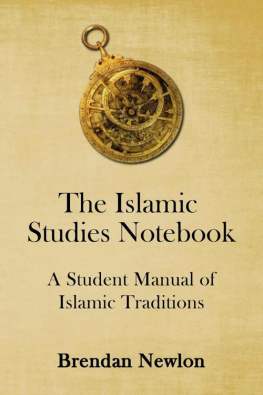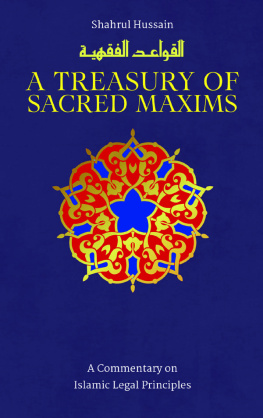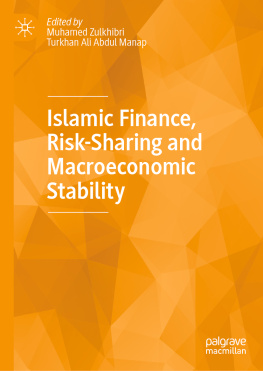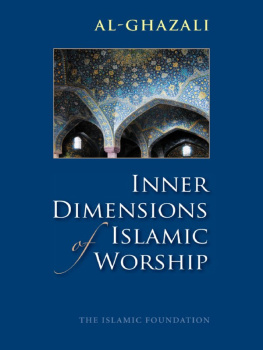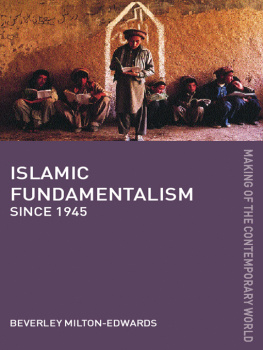Brendan Newlon - The Islamic Studies Notebook: A Student Manual of Islamic Traditions
Here you can read online Brendan Newlon - The Islamic Studies Notebook: A Student Manual of Islamic Traditions full text of the book (entire story) in english for free. Download pdf and epub, get meaning, cover and reviews about this ebook. year: 2018, genre: Religion. Description of the work, (preface) as well as reviews are available. Best literature library LitArk.com created for fans of good reading and offers a wide selection of genres:
Romance novel
Science fiction
Adventure
Detective
Science
History
Home and family
Prose
Art
Politics
Computer
Non-fiction
Religion
Business
Children
Humor
Choose a favorite category and find really read worthwhile books. Enjoy immersion in the world of imagination, feel the emotions of the characters or learn something new for yourself, make an fascinating discovery.
- Book:The Islamic Studies Notebook: A Student Manual of Islamic Traditions
- Author:
- Genre:
- Year:2018
- Rating:5 / 5
- Favourites:Add to favourites
- Your mark:
- 100
- 1
- 2
- 3
- 4
- 5
The Islamic Studies Notebook: A Student Manual of Islamic Traditions: summary, description and annotation
We offer to read an annotation, description, summary or preface (depends on what the author of the book "The Islamic Studies Notebook: A Student Manual of Islamic Traditions" wrote himself). If you haven't found the necessary information about the book — write in the comments, we will try to find it.
Brendan Newlon: author's other books
Who wrote The Islamic Studies Notebook: A Student Manual of Islamic Traditions? Find out the surname, the name of the author of the book and a list of all author's works by series.
The Islamic Studies Notebook: A Student Manual of Islamic Traditions — read online for free the complete book (whole text) full work
Below is the text of the book, divided by pages. System saving the place of the last page read, allows you to conveniently read the book "The Islamic Studies Notebook: A Student Manual of Islamic Traditions" online for free, without having to search again every time where you left off. Put a bookmark, and you can go to the page where you finished reading at any time.
Font size:
Interval:
Bookmark:
The Islamic Studies Notebook
A Student Manual of Islamic Traditions
Authors:
The students of RS 140A - Islamic Traditions
Summer 2017 at UCSB
Sean Knight
Trent Davidson
Leslie J.Acero
Kaitlyn Woodward
Ramzi Bekeri
Thao Nguyen
Anthony Khoa A. Tran
Sara Moretti
Alexandra Kineret
Blake Keane
Mingfei Xu
Afreen Chaus
Paul Pineda
Aniela Grych
Edited by:
Brendan Newlon
Copyright 2017 Brendan Newlon
All rights reserved.
ISBN: 1983551287
ISBN-13: 978-1983551284
For the students and teachers, scholars and seekers.
CONTENTS
By Brendan Newlon
From June 26 to August 3, 2017, I had the honor of teaching a six-week undergraduate Summer course on Islamic Traditions at the University of California, Santa Barbara. It was my first time teaching this course, and I was free to design my own syllabus and teaching plan. I began with the general theory that I didnt want to teach it as a cookie-cutter introduction to Islam course. Inspired by the course title and my own doctoral research on the phenomenon of Islamic traditionalism, I decided the most transparent approach to introduce my students to Islamic traditions would be to organize my teaching plan around what Muslims have traditionally taught Muslims about Islam. I would rely upon well-known elementary-level teaching manuals and other texts used in traditional Islamic educational settings throughout the world and instruct students according to traditional didactic methods. My goal was to approximate an insider learning experience for my students to explore Islamic traditions through something akin to participant-observation ethnography.
Due to the limitations of teaching such a broad topic in six weeks, a number of difficult decisions had to be made. The first was to focus almost exclusively on Sunni traditionalism, meaning that I did not attempt much more than a cursory mention of minority movements such as the Shia and Ahmadiyya traditions; alternate interpretations of Islam arising from Orientalist scholarship; modern reform projects such as Wahhabism, Salafism, and the Progressive-Muslims movement(s); or groups or phenomena restricted to narrow periods of time, political contexts, or geographic area like particular Sufi tariqas, Tablighi Jamaat, Hizmet, Muslim Brotherhood, or the Nation of Islam. On the other hand, I did address the pluralism inherent within Sunni traditionalism, particularly as expressed through the four surviving Sunni madhhabs , or schools of ritual-legal interpretation. In short, the course focused on the most basic, widely accepted, historically consistent, and well-known teachings of Islam.
Despite aggressively paring away to focus the course content, there was still too large a body of knowledge to cover anything more than the most central topics. As a Muslim scholar said:
Begin with what is most essential, for knowledge is vast as the seas,
While life is a fading vision that visits, or fleeting as a guest who soon leaves.
Begin by rectifying belief, then learn the correct performance of deeds,
Purification of the soul's inner character, and the sciences foundational to these.
Accordingly, the course was designed around the framework of the core religious teachings known within the Islamic tradition as the fard `ayn , or individual obligations, and was further divided into two sections: foundational sciences and advanced sciences. As the above poem would suggest, the foundational sciences include a basic understanding of theology ( aqidah ), daily ritual practice ( fiqh ), and the cultivation of a spiritual inward character ( tasawwuf, or sufism). The advanced sciences are those relied upon to derive and elaborate the foundational sciences, including Arabic language and linguistics ( fiqh al-lugha ), Quranic studies ( ulum al-Quran ), systematic classification of hadith transmission and narrations ( mustalah al-hadith ), scriptural exegesis ( tafsir ), Prophetic biography ( sira ), and so on.
In a traditional religious curriculum, Muslim students might already have some familiarity with these topics and how they relate to each other, so each could be taught independently. However, most non-Muslim undergraduates in an American university will need to begin by learning the basic story of Islam and what distinguishes it as a religious tradition it doesnt make sense to teach about the tools of scholarly analysis used to classify different types of narrations attributed to the Prophet Muhammad before the students understand who he was and why people would want to convey his words and actions from one generation to the next, let alone analyzing the fidelity of the transmission. These subjects require context. Since each subject interrelates organically on multiple levels with several other subjects, I decided to teach the subjects organically (read: all mixed together) and then try to help the students sort out what they had learned into different subjects as the course progressed.
The solution I settled upon was to have the students maintain a Course Manual as a living document in which they would record everything they had learned (whether from my lectures, the assigned readings, etc.) and constantly reorganize that information according to the traditional subject divisions that would be introduced and clarified throughout the course. Their goal was to envision it as a manual or short textbook to use as a reference that would enable you to teach the entire course on your own. Students were to submit the latest version of their Course Manual at the end of each week to receive feedback. However, after the second week, I realized that each students observations were unique, and each excelled at understanding a different aspects of the topics or presented what they had learned in a surprising and brilliant way. Some included more detail, while others were better organized. Observing this, I decided to make the Course Manual a collaborative project.
In the days that followed, the students integrated all of their work into a single document, and it grew at a surprising rate. As soon as one student would begin writing a section, others would jump to expand upon the topic from their own understanding. Taking into account the inclusion of the individual essay students would write later in the class, I estimated that our Course Manual might eventually reach eighty to one hundred pages.
I had heard of collaborative publishing as a teaching method, so I pitched the idea to the class. Actually, my pitch was somewhat rigged from the beginning: I asked everyone in the room to take turns explaining what excited them the most about the prospect of becoming an author and publishing a book on Islam. After a week, I asked the class if they really believed they would be able to write a book in a matter of weeks. After a thoughtful moment of silence, I wrote their updated word count on the board, added the anticipated count of their individual essays, and translated the number into book pages. Sixty-three pages! We were really going to publish a book! From then on, I would update them every few days on their progress, assign short writing assignments for homework, and encourage them to add short essays on topics of interest for extra credit.
You are now reading the resulting volume. It is the product of a collaborative effort by fourteen exceptionally dedicated undergraduate students from diverse backgrounds who are pursuing diverse fields of study. Im certain none of them imagined when they enrolled in a six-week Summer course on Islamic Traditions that they would co-author a book on the subject. Now that they have completed their project, I have no doubt that you will be as impressed as I am with what they have accomplished.
Font size:
Interval:
Bookmark:
Similar books «The Islamic Studies Notebook: A Student Manual of Islamic Traditions»
Look at similar books to The Islamic Studies Notebook: A Student Manual of Islamic Traditions. We have selected literature similar in name and meaning in the hope of providing readers with more options to find new, interesting, not yet read works.
Discussion, reviews of the book The Islamic Studies Notebook: A Student Manual of Islamic Traditions and just readers' own opinions. Leave your comments, write what you think about the work, its meaning or the main characters. Specify what exactly you liked and what you didn't like, and why you think so.

